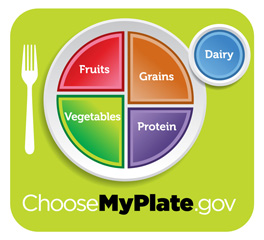Last Thursday the USDA put to rest the Food Pyramid we’ve all known, memorized and talked to for decades and launched their brand new tool for teaching people how to eat.
A plate.
To me, this is the first sign of how out of touch the USDA is with the issues facing most Americans when it comes to eating.
The problem is most Americans don’t eat meals involving plates. They are lucky to eat at a table at all. Many eat in their cars, at their desks, on the couch or at their children’s baseball practice but not at the actual dinner table. They eat whatever is easy to grab and doesn’t require cooking or utensils.
The plate, found at www.choosemyplate.gov, is sound in its advice. I often tell clients to think of their plate in 4 quarters: ¼ for protein, ¼ for starches (grains, fruits, starchy veggies) and half for the fibrous or leafy veggies. This is the advice I give them for parties or business meeting buffets where they need to manage food without the advantage of tools like measuring cups and scales.
This advice comes with much coaching about good choices. Why a premium chicken breast at Mickey D’s, with its multitude of additives, is different than a chicken breast you buy at the grocery or your local farmer. Why a real fruit smoothie at the same establishment, pumped up with sugar and flavoring, is not the same as a smoothie you make at home with fresh fruit.
People are confused about food, what’s good and what’s not, and the new guidelines don’t help make it any clearer. If a person gets most of their nutrition from a drive up window or the frozen food isle, the plate is a nice ideal but it doesn’t help them make that transition from junk food to real food. After all, I could meet the guidelines of the plate with mashed potatoes, peaches in syrup, a pork chop, rice and ice cream. Yet this plate would still be somewhat of nutritional nightmare.
When I suggest to someone they stop eating a breakfast burrito from the drive up as their usual breakfast their first question is “Well…then what do I eat?” Real food is often something exotic and foreign, like tofu to a meat eater. To me it’s an easy question to answer-make your own burrito. Scramble some egg whites, add peppers, onions, mushrooms and low fat cheese. Wrap in a whole grain tortilla. It doesn’t fit the plate but you have protein, whole grains, dairy and veggies. Grab a banana and you’ve got an on the go breakfast. This makes sense to most people. A breakfast plate just isn’t a realistic goal for many in our on the go world.
The issue is food and real world norms about food have to change, not the symbol. You can use a pyramid, a plate, a map or Legos but nothing is going to work until we stop accepting overly processed junk as food and start teaching people what real food is all about.



